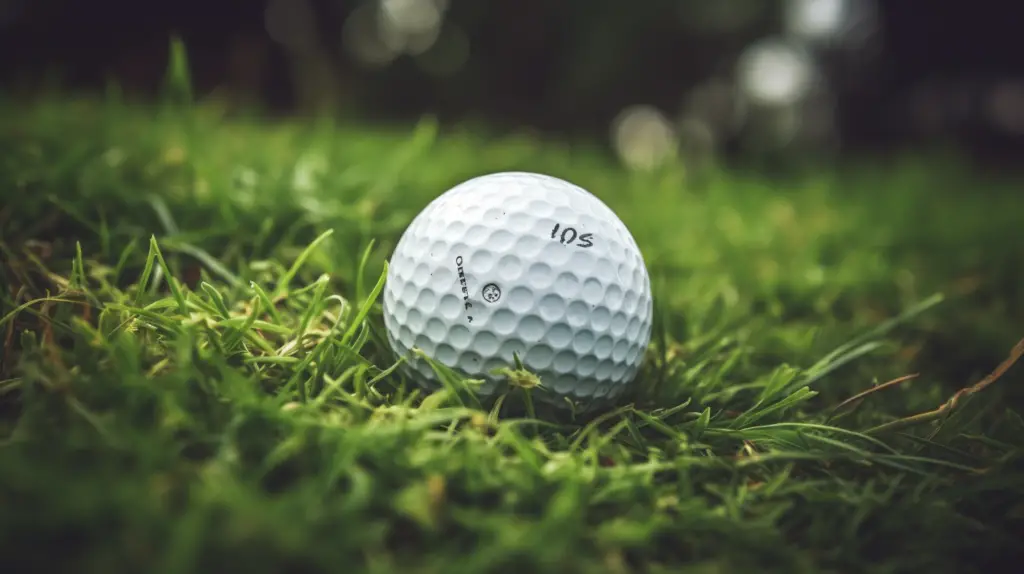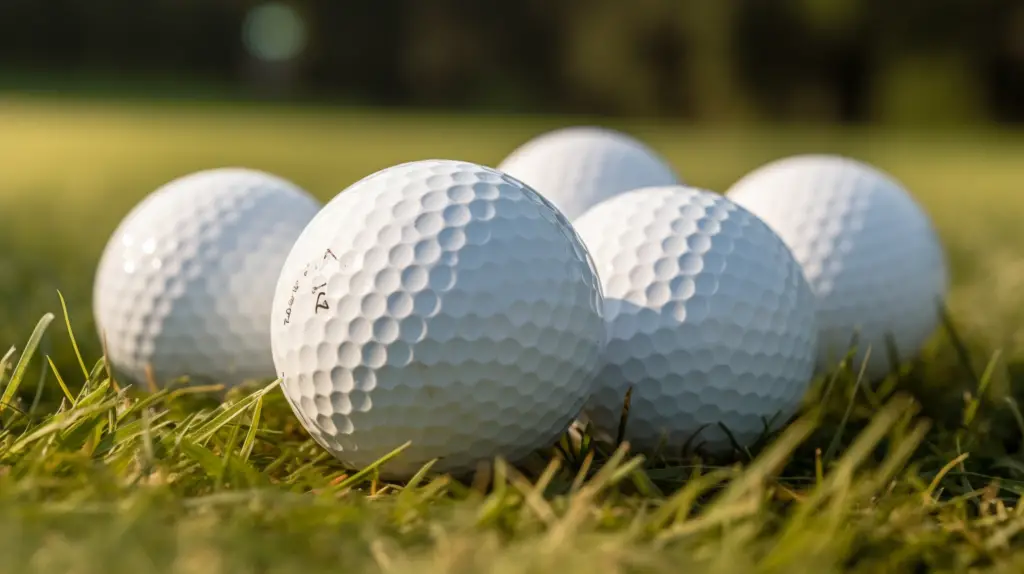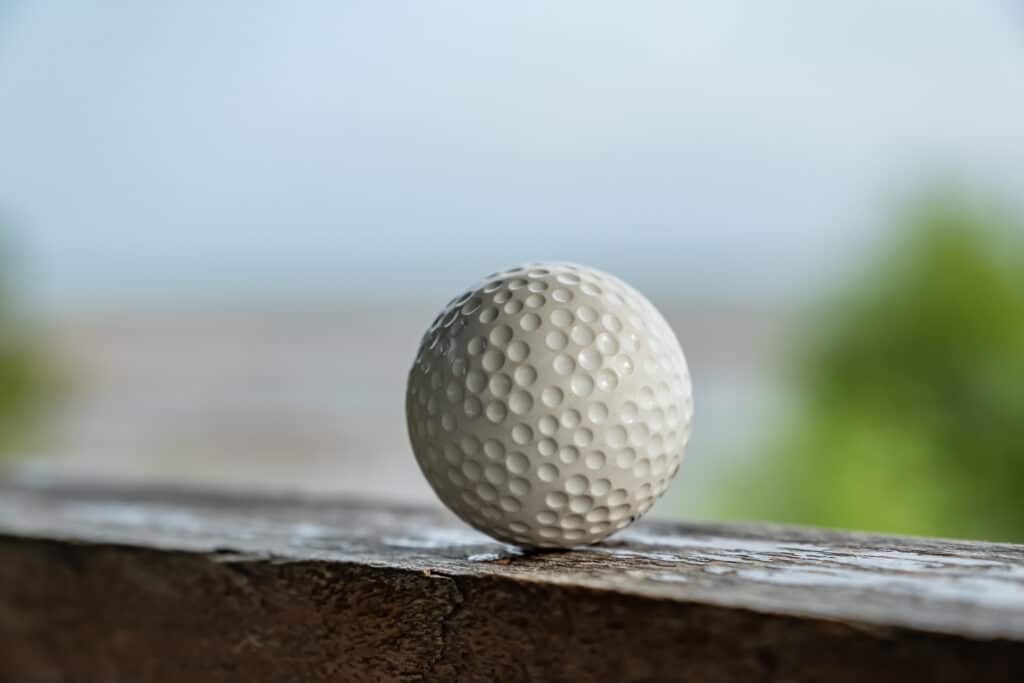Last Updated on October 24, 2023
Golf is a game that has been around for centuries, and it’s beloved by millions of people worldwide. Have you ever wondered why golf balls have dimples? Well, the answer may surprise you. Contrary to popular belief, those tiny indentions are actually an important part of the ball’s structure — they help make the ball fly further and straighter than it otherwise would. In this article, we’ll explain exactly why do golf balls have dimples and how these small details can drastically improve your performance on the course.
Aerodynamics
Golf balls have dimples because of the aerodynamics they create. The dimples help to reduce drag and turbulence, which allows the golf ball to travel farther when hit with a club. This happens due to the air flowing around the golf ball’s dimple pattern, creating an area of low pressure behind it that pulls it forward as it moves through the air. Dimples also increase spin rate, allowing for more control over the direction in which a golf ball is hit. Finally, they improve accuracy by reducing sidespin and providing greater distance on shots off-centre contact with the clubface. All this adds up to the increased performance on each shot taken by any golfer.
Dimple Design
Golf balls are designed with dimples for a variety of reasons. Dimples help to reduce drag on the golf ball and increase its lift, which helps it fly farther and straighter than a smooth ball would. The size, shape, and pattern of the dimple design all contribute to how efficiently air flows around the golf ball while in flight. There are several different types of dimple technology used in today’s modern golf balls depending on factors such as optimal speed, spin rate, trajectory and distance performance.
The most common type of dimple design is an icosahedral pattern, made up of 300 identical-sized dimples arranged in 20 rows of 15 each. This symmetrical arrangement provides uniform airflow over the entire surface area of the golf ball during flight. Other more specialized patterns may also be found on some modern golf balls that feature larger shallow dimples or multiple sizes of deeper ones for enhanced performance characteristics such as higher launch angles and lower levels of spin off the tee. Additionally, there may be variations in dimple size from one manufacturer to another based on their proprietary designs.
Regardless of what type is used, though, having strategically placed small indentations on a golf ball is essential when trying to maximize both distance and accuracy during play. Without them, a golfer would have difficulty getting any sort of consistent results since even slight imperfections can cause significant changes in aerodynamics. Properly engineered dimple patterns allow players to fine-tune their shots using just minor adjustments rather than major swing changes or club selections.
Difference In Dimple Patterns
The design of a golf ball dimple can vary significantly depending on the manufacturer. The shape, depth, pattern, spacing and size of each dimple will all have an impact on how far and straight the ball travels when hit with a club.
There are several types of dimples which affect flight:
- Shape: Some manufacturers use round or circular dimples for a more consistent spin, while others might use tetrahedral shapes to reduce drag and increase distance.
- Depth: Dimples that are deeper into the surface cause less air resistance, allowing them to travel further distances than shallower designs.
- Pattern: Different patterns, such as symmetrical or asymmetrical configurations, can be used to control lift and direction.
- Spacing: Closer-spaced dimples help create greater backspin, while wider ones produce higher launch angles.
- Size: Smaller-sized dimples may help decrease drag, but larger ones generate more lift in order to reach longer distances.
Each type of dimple has its own advantages and disadvantages, so it is important for players to test out different styles before deciding what works best for their game. It’s also beneficial for players to understand how changing one element affects other elements in order to get the most from their shots. Understanding these differences can lead to improved performance on the course while helping golfers gain a better understanding of why they achieve certain results with certain balls.
Impact Of Dimples On Spin And Distance

The dimples on a golf ball have an important impact on its aerodynamics. As the ball travels through the air, the dimples create turbulence that cause increased drag and lift, which affect both spin and distance.
Due to the way in which dimpled balls interact with airflow, they will travel farther than a smooth-surfaced ball, even when hit with the same force. This is because the turbulent airflow creates more friction between the ball and air molecules, thus creating less resistance for it to move forward. Moreover, this turbulent flow also causes additional backspin on the ball due to what is known as the Magnus effect; this further increases its distance by allowing it to carry higher up into the air before descending again. Additionally, having dimples can reduce side spin, helping keep shots straighter instead of veering off course.
In summary, dimples increase distances and help control spin thanks to their impacts on aerodynamic performance – making them key features in any game of golf.
Testing The Effects Of Dimples On Ball Movement

Dimple testing is an important part of golf ball design and performance. To understand how dimples affect the movement of a golf ball, aerodynamic tests can be conducted to analyze its trajectory. These tests measure the drag coefficient of a golf ball while it moves through different air densities and velocities. It has been found that when compared to a smooth surface ball, dimpled balls experience less drag, allowing them to travel farther with greater accuracy.
In addition to reducing drag, dimples also cause the golf ball to spin faster in flight which allows for more control over its direction. The shape and size of the dimple pattern are key factors in determining how well a golf ball will perform on any given course. By adjusting these features during the manufacturing process, manufacturers can create unique designs tailored for specific players or courses. This type of customization helps ensure each golfer gets optimal performance from their chosen golf ball no matter what kind of shot they’re playing.
The Physics Behind Dimples
The physics behind why golf balls have dimples is an interesting and complex concept. Dimple design, pattern, and depth are all important factors that affect the aerodynamics of a golf ball. When air passes over the surface of a smooth golf ball, turbulence creates drag which hinders its movement. The dimples reduce this drag by creating vortices around the ball as it spins through the air. This helps to keep a consistent flow of air across its surface, thus increasing lift and distance covered by spin.
Additionally, different dimple patterns can also influence how far each shot travels in comparison with others due to their ability to change the trajectory of the golf ball’s flight path. For example, shallow-depth dimples create more backspin on shots, while deeper-depth dimples provide less backspin but more carry distance. By understanding these principles, manufacturers are able to optimize their designs for various club types, thereby improving overall performance during play.
Overall, dimpled surfaces act like tiny wings on a golf ball, allowing it to travel farther than if it was left without any such features at all when hit off the tee or fairway. With careful engineering and testing, manufacturers can precisely tune dimple patterns for optimal performance on every type of golf shot imaginable, resulting in improved accuracy and greater control over golf ball movement.
Frequently Asked Questions
How Often Should I Change My Golf Balls?
When it comes to golf balls, most players want to know how often they should be replaced. After all, the right golf ball can make a huge difference in your game. Depending on how frequently you play and what type of conditions you’re playing in, there is no one-size-fits-all answer for when to replace them.
Understanding the life expectancy of your golf balls can help you decide when it’s time for a replacement. Generally speaking, if you are an avid golfer who plays several times per week, then frequent golf ball replacement is recommended. However, if you only hit the links once or twice a month, then replacing them less often may suffice. Also, consider things like climate and terrain; extreme weather conditions can accelerate wear on golf balls more quickly than normal circumstances.
It’s important to remember that while new golf balls come with certain advantages, such as improved distance and spin rates, these benefits become diminished over time due to regular use. Therefore it’s wise to assess your needs periodically and adjust your strategy accordingly in order to ensure peak performance every round.
Conclusion
In conclusion, golf balls have dimples for a few different reasons. First, the dimples create more spin on the ball when it’s hit. This helps to control shots and make them more accurate. Second, the dimples reduce drag as the ball flies through the air, allowing it to travel farther than if it were smooth. Finally, they also allow you to add backspin or sidespin on approach and chip shots which can give you better distance control.
Knowing how often to replace your golf balls is important in order to get the most out of each one. Generally speaking, if you are playing regularly, then you should be changing your golf balls every couple of rounds or so. But this may vary depending on what type of golfer you are and what level of play you are at. It’s also important to remember that there is no ‘one size fits all’ answer; what works for you might not work for someone else.



